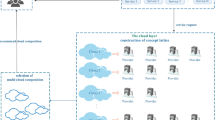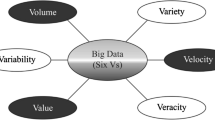Abstract
Because of their unique electronic, magnetic and optical features, the rare earth has become an important strategic resource. Moreover, improving the exploitation of rare earth resources is very significant. To our knowledge, for the first time the hierarchical clustering technology under Map Reduce environment is utilized to process the experiment data of the tailings of rare earth ion in this paper. According to analyze of the experiment data, the leaching trend of rare earth ions in tailings under optimum conditions is researched. Finally, the data analysis shows that when the volume of sampling location is 400 ml, it can not only increase the concentration of rare earth ions in the leaching solution to ensure the economy and maneuverability of subsequent rare earth enrichment, but also insure the leaching rate of rare earth in the tailings and improve the utilization ratio of rare earth resources.





Similar content being viewed by others
References
Chi, R., Tian, J.: The Weathered Crust Elution-deposited Rare Earth Ore. Nova Science Publisher, New York (2008)
Liu, J., Wu, A.: Study on the hydrodynamics of heap leaching process. J. Math. Theory Appl. 26(3), 123–125 (2006)
Tian, J., Chi, R., Yin, J.: Leaching process of rare earth from weathered crust elution-deposited rare earth ore. J. Trans. Nonferrous Metals Soc. China 20, 892–896 (2010)
Li, B., Wang, N., Wan, J., Xiong, S., Liu, H., Li, S., Zhao, R.: In-situ gamma-ray survey of rare-earth tailings dams e A case study in Baotou and Bayan Obo Districts. China. J. Environ. Radioact. 151, 304–310 (2016)
Tang, H., Wang, X., Shuai, W., Liu, Y.: Immobilization of rare earth elements of the mine tailings using phosphates and lime. In: The Tenth International Conference on Waste Management and Technology (ICWMT), pp. 255–263, Elsevier (2016)
Qian, L., Luo, Z., Du, Y., Guo, L.: Cloud computing: an overview. In: Proceedings of the Conference on Cloud Computing (CloudCom). IEEE Computer Society (2009)
Hamza, A.: Data mining in cloud computing. J. Sci. Eng. Res. 6(1), 1051–1056 (2015)
Liu, Q., Cai, W., Shen, J., Fu, Z., Liu, X., Linge, N.: A speculative approach to spatial-temporal efficiency with multi-objective optimization in a heterogeneous cloud environment. J. Secur. Commun. Netw. 9(17), 4002–4012 (2016)
Kong, Y., Zhang, M., Ye, D.: A belief propagation-based method for task allocation in open and dynamic cloud environments. J. Knowl. Based Syst. 115, 123–132 (2016)
Shang, F., Chen, X., Yan, C.: A strategy for scheduling reduce task based on intermediate data locality of the MapReduce. J. Clust. Comput. 20(4), 2821–2831 (2017)
Abdolazimi, R., Naderi, H., Sagharichian, M.: Connected components of big graphs in fixed MapReduce rounds. J. Clust. Comput. 20(3), 2563–2574 (2017)
Yu, Z., Su, X., Qi, P., Ma, P.: Deadlock avoiding based on future lockset. J. Comput. Res. Dev. 54(2), 428–445 (2017)
Verma, A., Cho, B., Zea, N., Gupta, I., Campbell, R.H.: Breaking the mapreduce stage barrier. J. Clust. Comput. 16(1), 235–244 (2013)
Vrba, Z., Halvorsen, P., Griwodz, C., Beskow, P.: Kahn process networks are a flexible alternative to mapreduce. In: Proceedings of the IEEE International Conference on High Performance Computing and Communications, pp. 154–162. IEEE Computer Society (2009)
Chen, P., Su, Y., Chang, J., Shieh, C.: Variable-sized map and locality aware reduce on public-resource grids. In: Proceedings of Advances in Grid and Pervasive Computing (GPC), pp. 234–243. Springer, New York (2010)
Dou, A., Kalogeraki, V., Gunopulos, D., Tuulos, V.: Misco: a mapreduce frameworkfor mobile systems. In: Proceedings of International Conference on Pervasive Technologies Related to Assistive Environments (PETRA 2010). ACM (2010)
Zaharia, M., Elmeleegy, K., Borthakur, D., Shenker, S., Sarma, J., Stoica, I.: Delay scheduling: a simple technique for achieving locality and fairness in cluster scheduling. In: Proceedings of EuroSys 2010 Conference, pp. 265–278. ACM (2010)
Polo, J., Carrera, D., Becerra, Y., Whalley, I.: Performance-driven task co-scheduling for mapreduce environments. In: Proceedings of IEEE/IFIP Network Operations and Management Symposium, pp. 373–380. IEEE (2010)
Bicer, T., Jiang, W., Agrawal, G.: Supporting fault tolerance in a data-intensive computing middleware. In: Proceedings of IEEE International Symposium on Parallel & Distributed Processing, pp. 1–12. IEEE (2010)
Kontagora, M., Velez, H.G.: Benchmarking a mapreduce environment on a full virtualization platform. In: Proceedings of International Conference on Complex, Intelligent and Software Intensive Systems, pp. 433–438. IEEE (2010)
Kim, K., Jeon, K., Han, H., Kim, S., Jung, H., Yeom, H.: MRBench: a benchmark for mapreduce framework. In: Proceedings of International Conference on Parallel and Distributed Systems, pp. 11–18. IEEE (2008)
Sandholm, T., Lai, K.: MapReduce optimization using regulated dynamic prioritization. J. Perform. Eval. Rev. 37(1), 299–310 (2009)
Wei, W., Du, J., Yu, T., Gu, X.: SecureMR: a service integrity assurance framework for mapreduce. In: Proceedings of Annual Computer Security Applications Conference (ACSAC 2009), pp. 73–82. IEEE (2009)
Liu, Q., Todman, T., Luk, W.: Combining optimizations in automated low power design. In: Proceedings of Design, Automation & Test in Europe Conference & Exhibition (DATE 2010), pp. 1791–1796. IEEE (2010)
Feller, E., Ramakrishnan, L., Morin, C.: Performance and energy efficiency of big data applications in cloud environments: a Hadoop case study. J. Parallel Distrib. Comput. 80, 80–89 (2015)
Nghiem, P., Figueira, S.: Towards efficient resource provisioning in MapReduce. J. Parallel Distrib. Comput. 95, 29–41 (2016)
Chitra, S., Madhusudhanan, B., Sakthidharan, G.R., Saravanan, P.: Local minima jump PSO for workflow scheduling in cloud computing environments. In: Advances in Computer Science and Its Applications, pp. 1225–1234. Springer, Berlin (2014)
Sarafis, I., Zalzala, A., Trinder, P.W.: A genetic rule-based data clustering toolkit. In: Proceedings of the Congress on Evolutionary Computation, pp. 1238–1243. Honolulu, USA (2012)
Wang, J., Zhang, Z., Xia, F., Yuan, W., Lee, S.: An energy efficient stable election-based routing algorithm for wireless sensor networks. J. Sens. 13(11), 14301–14320 (2013)
Gu, B., Sheng, V.S., Tay, K.Y., Romano, W., Li, S.: Incremental support vector learning for ordinal regression. J. IEEE Trans. Neural Netw. Learn. Syst. 26(7), 1403–1416 (2015)
Natthakan, I., Tossapon, B.: Generating descriptive model for student dropout: a review of clustering approach. J. Hum. Centric Comput. Inf. Sci. 7, 1 (2017)
Nagpal, G., Uddin, M., Kaur, A.: A comparative study of estimation by analogy using data mining techniques. J. Inf. Process. Syst. 8(4), 621–652 (2012)
Acknowledgements
This work is supported by the NSFC (61772454, 61772280, 51364015), the research fund from Jiangsu Technology & Engineering Center of Meteorological Sensor Network in NUIST under Grant (KDXG1301), the PAPD fund from NUIST, and the Human Resources Development program (20164030300230) of the Korea Institute of Energy Technology Evaluation and Planning (KETEP) grant funded by the Korea government Ministry of Trade, Industry and Energy. Professor Jeong-Uk Kim is the corresponding author.
Author information
Authors and Affiliations
Corresponding author
Rights and permissions
About this article
Cite this article
Ren, Y., Wang, J., Feng, X. et al. A hierarchical clustering based method to evaluate reuse of rare earth tailings under cloud computing environment. Cluster Comput 22 (Suppl 1), 1805–1814 (2019). https://doi.org/10.1007/s10586-017-1654-1
Received:
Revised:
Accepted:
Published:
Issue Date:
DOI: https://doi.org/10.1007/s10586-017-1654-1




